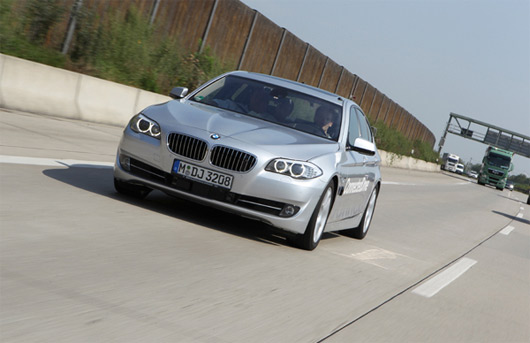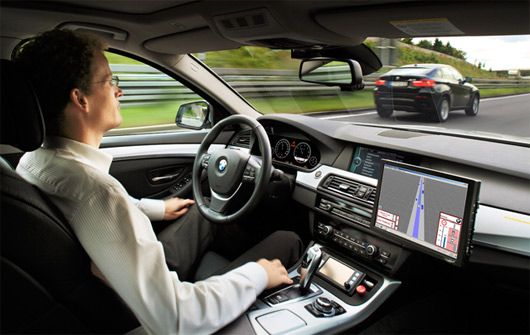BMW autopilot drove along the Munich-Nuremberg Autobahn
The German company BMW has joined the ranks of those who test automatic vehicle control systems without driver assistance. Previously, road tests were carried out by Google and Volkswagen. The only difference is that the listed companies used economical low-speed models for testing (for example, Google uses the Toyota Prius), but BMW equipped the 5-series sedan with a robotic control system, well known to fast-driving enthusiasts.

BMW conducted road tests on the A9 Autobahn from Munich to Nuremberg. This is a road with no maximum speed limit with high traffic intensity. BMW autopilot can independently go along the route, slow down, accelerate and overtake slow road users.

As with Volkswagen autopilot, BMW developers used existing developments that are installed on BMW production cars. These are BMW TrackTrainer systems (for driving along a racetrack along an ideal trajectory, used to train riders), traffic jam assistant and emergency stop assistant.
Emergency Stop Assistant is a system that is now being installed on BMW cars, primarily for elderly drivers (it is being created as part of the SmartS Senior program, launched in May 2009 by the German Ministry of Education and Research). Her task is that if the driver faints behind the wheel, the car is able to go into offline mode of travel and make an emergency stop. In this case, the system turns on the hazard warning light, controls the maneuvers of the car and, depending on the traffic situation, automatically stops the car in the far right lane.
From the technical stuffing in BMW autopilot, several sensors are used (lidar, radar, ultrasound and cameras) from all sides of the car. To predict the future trajectory of the road, a GPS system and digital maps are used, plus a camera for the tracking system for road markings. Objects in front of the car (as well as at the rear and side) are detected using active cruise control radar sensors with Stop & Go function, as well as an additional laser scanner.
The BMW Group department's traffic automation project is led by Dr. Nico Campfchen. The work has been going on for many years - the autopilot has already traveled more than 5,000 km in testing mode.

Autopilot is activated at the touch of a button. “For the driver, this is a new and unusual situation when driving is completely transferred to the hands of a special system. However, thanks to a very flexible, confident and reliable management, in a few minutes the driver begins to trust the car, ”said Dr. Nico Campfchen. “Despite this, it is the driver who is responsible for what is happening and controls what is happening on the road.” The main goal of the developers was to make sure that the actions of the autopilot on the road did not differ from the actions of other participants in the movement.
Thus, BMW cars are already able to automatically park, carry out an emergency stop, drive along the racetrack and on the autobahn. “The next thing our prototype would like to teach,” says Dr. Nico Campfchen, is interaction with road repair sites and intersections. Already now, a question arises with repair work, how to recognize and localize the whole variety of forms of this phenomenon and which action strategy to use, ”said the lead developer.

BMW conducted road tests on the A9 Autobahn from Munich to Nuremberg. This is a road with no maximum speed limit with high traffic intensity. BMW autopilot can independently go along the route, slow down, accelerate and overtake slow road users.

As with Volkswagen autopilot, BMW developers used existing developments that are installed on BMW production cars. These are BMW TrackTrainer systems (for driving along a racetrack along an ideal trajectory, used to train riders), traffic jam assistant and emergency stop assistant.
Emergency Stop Assistant is a system that is now being installed on BMW cars, primarily for elderly drivers (it is being created as part of the SmartS Senior program, launched in May 2009 by the German Ministry of Education and Research). Her task is that if the driver faints behind the wheel, the car is able to go into offline mode of travel and make an emergency stop. In this case, the system turns on the hazard warning light, controls the maneuvers of the car and, depending on the traffic situation, automatically stops the car in the far right lane.
From the technical stuffing in BMW autopilot, several sensors are used (lidar, radar, ultrasound and cameras) from all sides of the car. To predict the future trajectory of the road, a GPS system and digital maps are used, plus a camera for the tracking system for road markings. Objects in front of the car (as well as at the rear and side) are detected using active cruise control radar sensors with Stop & Go function, as well as an additional laser scanner.
The BMW Group department's traffic automation project is led by Dr. Nico Campfchen. The work has been going on for many years - the autopilot has already traveled more than 5,000 km in testing mode.

Autopilot is activated at the touch of a button. “For the driver, this is a new and unusual situation when driving is completely transferred to the hands of a special system. However, thanks to a very flexible, confident and reliable management, in a few minutes the driver begins to trust the car, ”said Dr. Nico Campfchen. “Despite this, it is the driver who is responsible for what is happening and controls what is happening on the road.” The main goal of the developers was to make sure that the actions of the autopilot on the road did not differ from the actions of other participants in the movement.
Thus, BMW cars are already able to automatically park, carry out an emergency stop, drive along the racetrack and on the autobahn. “The next thing our prototype would like to teach,” says Dr. Nico Campfchen, is interaction with road repair sites and intersections. Already now, a question arises with repair work, how to recognize and localize the whole variety of forms of this phenomenon and which action strategy to use, ”said the lead developer.
